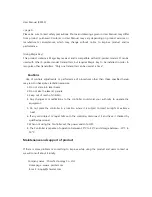
Compliance, safety, and intended use
25
Mako U Technical Manual V1.1.8
Compressed air
We recommend wet cleaning, see
If wet cleaning does not succeed, we recommend you to contact
In general, compressed air should be avoided. Wrong handling can damage optical
components irreversibly, especially the sensitive sensor. If you want to use
compressed air in spite of all warnings, consider:
•
High pressure air may crack the sensor or glass you want to clean.
•
Compressed air may contain oil that could contaminate or damage the optical
components.
•
Compressed air may blow dust into cameras and lenses.
Heat dissipation
Operation outside the allowed temperature range can damage the camera.
For best performance and to protect the camera from damage, keep the housing
temperature b5 °C and +45 °C for operation. Observe the following:
•
To avoid camera crashes, operate the camera with a lens or lens adapter
attached only.
•
For maximum heat dissipation, affix the camera to a heat sink, using the
mounting threads (see
-
Use mounting base and heat sink with large surface areas.
-
Use a mounting base with a high thermal conductivity.
•
Reduce ambient temperature. For example, in an outdoor application with
direct sunlight, provide shading by an enclosure.
•
Provide ventilation or other active cooling of camera, mounting base, and heat
sink.
BIOS drivers
Sometimes, USB 3.0 component's firmware must be updated before operation,
including devices, such as host adapters cards.
To avoid damage and to benefit from possible updates to increase performance:
Check for BIOS updates related to USB 3.0.
















































